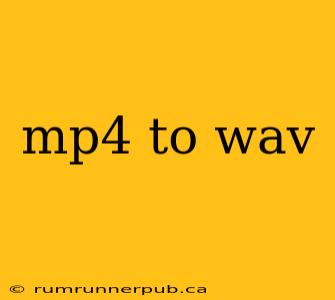Converting MP4 files to WAV format is a common task for audio editing, archiving, and various other applications. While seemingly simple, understanding the nuances of the conversion process ensures you maintain audio quality and avoid common pitfalls. This article leverages insights from Stack Overflow to provide a clear, practical guide, enhanced with additional explanations and examples.
Why Convert MP4 to WAV?
MP4 is a versatile container format that can hold both video and audio data, often compressed using codecs like AAC or HE-AAC. WAV, on the other hand, is an uncompressed audio format, offering high fidelity and preserving audio quality. Therefore, conversion is necessary when:
- High-fidelity audio editing: WAV's uncompressed nature is crucial for professional audio editing where even minor compression artifacts can be detrimental.
- Archiving: WAV offers a reliable long-term storage solution, minimizing the risk of audio degradation over time associated with compressed formats.
- Compatibility: Some audio software or hardware may have limited MP4 support, requiring a WAV conversion for proper functionality.
Methods for MP4 to WAV Conversion
Several methods exist for converting MP4 to WAV, each with its own advantages and disadvantages. We'll explore the most common approaches, drawing from the collective wisdom of the Stack Overflow community.
1. Using Command-Line Tools (FFmpeg)
FFmpeg, a powerful and versatile command-line tool, is often recommended by Stack Overflow users for its efficiency and flexibility. (See numerous discussions on Stack Overflow regarding FFmpeg's capabilities for audio conversion, e.g., similar questions regarding FFmpeg's usage).
A typical command would be:
ffmpeg -i input.mp4 -vn -acodec pcm_s16le -ar 44100 output.wav
-i input.mp4: Specifies the input MP4 file.-vn: Disables video processing (we only need audio).-acodec pcm_s16le: Sets the audio codec to PCM (uncompressed) with 16-bit samples in little-endian format – a standard for WAV.-ar 44100: Sets the sample rate to 44.1 kHz, a common standard for CD-quality audio. You can adjust this based on your needs.
Analysis: FFmpeg provides fine-grained control over the conversion process, allowing for adjustments to sample rate, bit depth, and channels. However, it requires familiarity with the command line.
2. Using GUI-Based Software
Several user-friendly applications offer MP4 to WAV conversion with graphical interfaces. Audacity, a free and open-source audio editor, is a popular choice (again, search Stack Overflow for "Audacity MP4 to WAV" to find many examples). These tools generally involve importing the MP4 file and then exporting it as a WAV file through a simple menu option.
Analysis: GUI-based software offers ease of use, making it ideal for users unfamiliar with command-line tools. However, they may lack the fine-grained control offered by FFmpeg.
3. Online Converters
Numerous online websites provide MP4 to WAV conversion services. However, caution is advised. Ensure the website is reputable to avoid malware or privacy concerns. (Stack Overflow discussions on online converters often highlight security issues, so it's best to research specific tools before using them).
Analysis: Online converters offer convenience, particularly for single conversions. However, they often have limitations on file size and might not offer the same level of control as dedicated software.
Choosing the Right Method
The optimal method depends on your technical skills, desired level of control, and the number of conversions needed.
- For beginners or single conversions: GUI-based software or a reputable online converter are convenient options.
- For batch processing or advanced control: FFmpeg provides the most flexibility and efficiency.
- For security-conscious users: Avoid unreliable online converters and opt for local software installations.
Beyond the Conversion: Maintaining Audio Quality
Remember that converting from a compressed format (like MP4's AAC) to an uncompressed format (WAV) does not magically improve audio quality. The original audio data dictates the upper limit of quality. However, WAV ensures that the existing audio quality is preserved without further compression artifacts.
By understanding the different methods and their trade-offs, you can effectively convert your MP4 files to WAV, preserving your audio and making it suitable for various applications. Remember to always back up your original files before performing any conversions.
